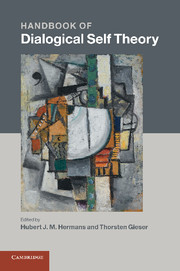Crossref Citations
This Book has been
cited by the following publications. This list is generated based on data provided by Crossref.
Rowan, John
2013.
Early Days in Humanistic and Transpersonal Psychology.
Self & Society,
Vol. 40,
Issue. 2,
p.
47.
Lehmann, Olga V.
2014.
The Catalyzing Mind.
p.
239.
Slobin, Dan I.
2014.
Language in Interaction.
Vol. 12,
Issue. ,
p.
315.
Esteban-Guitart, Moisès
and
Moll, Luis C
2014.
Funds of Identity: A new concept based on the Funds of Knowledge approach.
Culture & Psychology,
Vol. 20,
Issue. 1,
p.
31.
Crossley, Adam R.
and
Lawthom, Rebecca
2015.
Dialogical Demand: Discursive Position Repertoires for a Local and Global UK Sex Industry.
Journal for the Theory of Social Behaviour,
Vol. 45,
Issue. 2,
p.
261.
Grebenyuk, E.G.
2015.
Witnessing in psychotherapy.
Counseling Psychology and Psychotherapy,
Vol. 23,
Issue. 3,
p.
93.
Aveling, Emma-Louise
Gillespie, Alex
and
Cornish, Flora
2015.
A qualitative method for analysing multivoicedness.
Qualitative Research,
Vol. 15,
Issue. 6,
p.
670.
Grimmett, Helen
2016.
The Problem of “Just Tell Us”: Insights from Playing with Poetic Inquiry and Dialogical Self Theory.
Studying Teacher Education,
Vol. 12,
Issue. 1,
p.
37.
Nir, Bracha
2017.
Resonance as a resource for stance-taking in narratives.
Functions of Language,
Vol. 24,
Issue. 1,
p.
94.
Hanke Jarošová, Světla
2018.
Multiplicity in the Unity of the Human and Ecclesial Person: How Dialogical Self Theory Can Be Stimulating for Contemplating the Church.
Studia theologica,
Vol. 20,
Issue. 3,
p.
75.
Tateo, Luca
2018.
The cultures of grief: The practice of post-mortem photography and iconic internalized voices.
Human Affairs,
Vol. 28,
Issue. 4,
p.
471.
Ellis, Basia D
and
Bhatia, Sunil
2019.
Cultural psychology for a new era of citizenship politics.
Culture & Psychology,
Vol. 25,
Issue. 2,
p.
220.
Bourke, Kenna
de Abreu, Guida
and
Rathbone, Clare J.
2019.
“I’m Just Who I Am”: Self-Continuity and the Dialogical Self in a Study of Migrants.
Journal of Constructivist Psychology,
Vol. 32,
Issue. 3,
p.
274.
Altamirano-Droguett, Janet Janet
Nail-Kroye, Óscar Ricardo
and
Monereo-Font, Carles
2020.
Incidentes críticos y su aporte a la identidad profesional de la matrona docente en Chile.
Investigación en Educación Médica,
Vol. 9,
Issue. 35,
p.
38.
Kałowski, Piotr
2020.
Truth and Falsehood in Science and the Arts.
Scardigno, Rosa
Grattagliano, Ignazio
Manuti, Amelia
and
Mininni, Giuseppe
2020.
The Discursive Construction of Certainty and Uncertainty in the Scientific Texts of Forensic Psychiatry.
East European Journal of Psycholinguistics,
Vol. 7,
Issue. 1,
Sawa, Magdalena
2020.
"We need to rediscover the living body" : Gabriel Josipovici's metamodern project in Goldberg: Variations.
Brno studies in English,
p.
261.
Zawisza, Rafał
2020.
Prawda i fałsz w nauce i sztuce.
Kałowski, Piotr
2020.
Prawda i fałsz w nauce i sztuce.
Page, David L.
2021.
Music & Soundscapes of our everyday lives: Music & Sound-making, meaning-making, and self-making.
Personal and Ubiquitous Computing,
Vol. 25,
Issue. 4,
p.
705.





